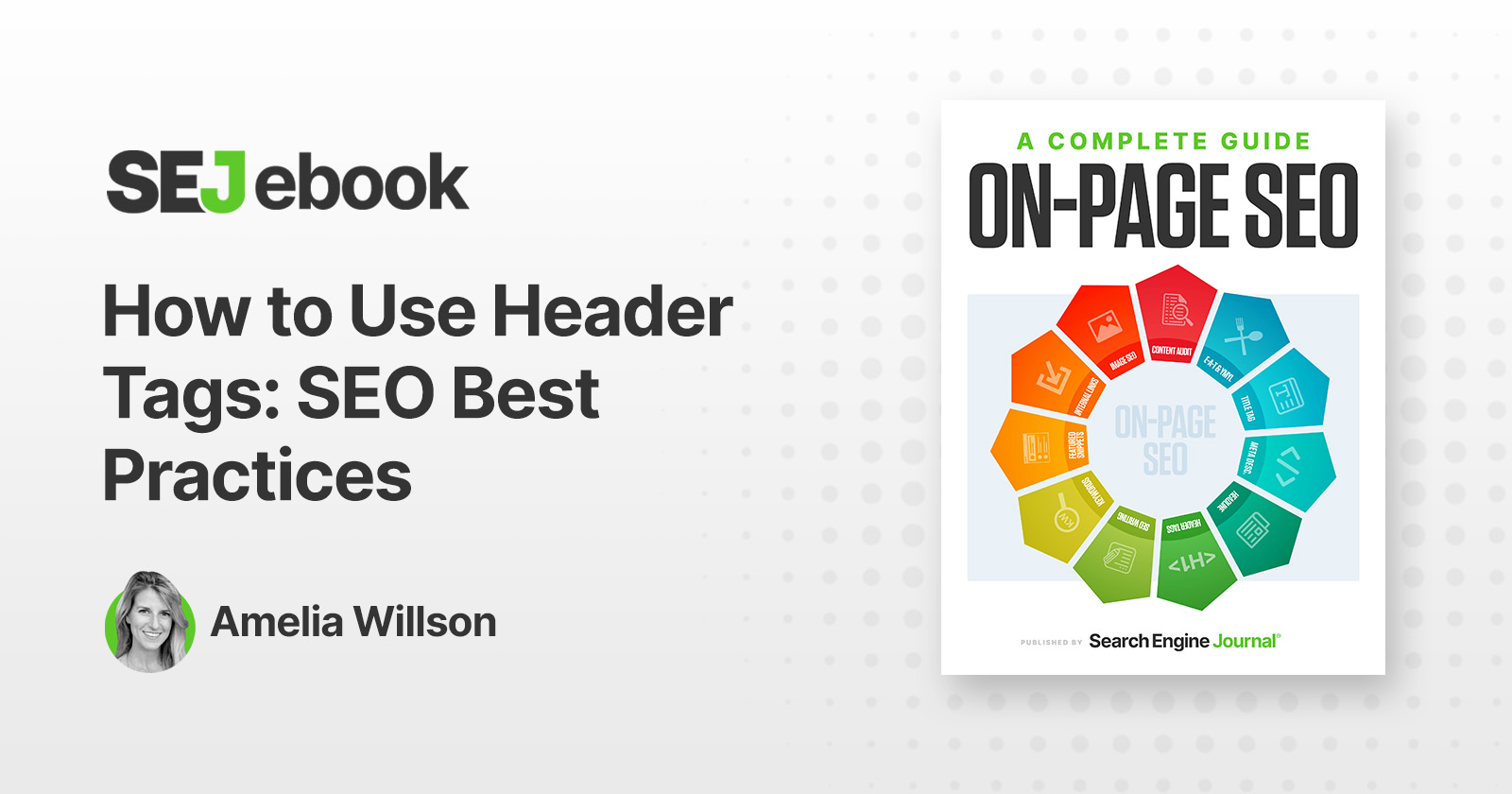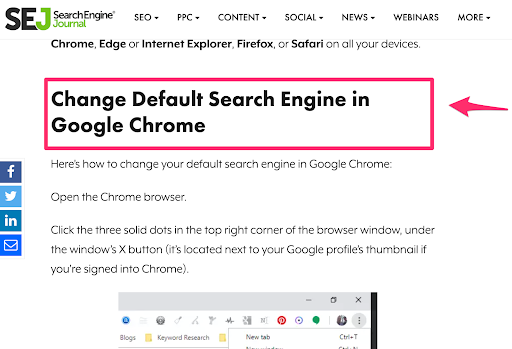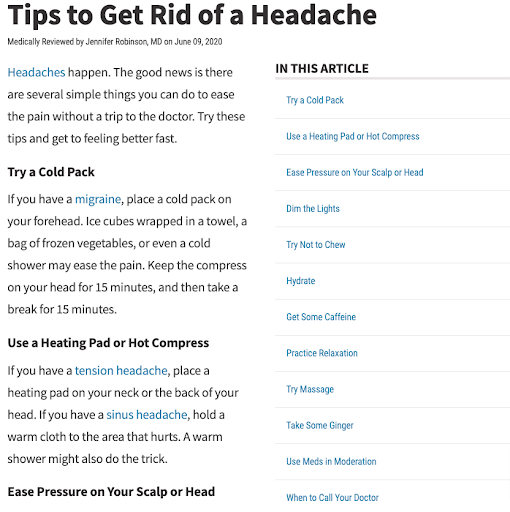
Header tags are still a strong signal for SEO. Google’s John Mueller said it himself:
“[W]hen it comes to text on a page, a heading is a really strong signal telling us this part of the page is about this topic.”
Header tags are a simple yet critical part of SEO. Use them wisely and you’ll please the search engine gods, as well as your users.
Here are seven best practices to follow when crafting yours.
What Is A Header Tag?
Header tags are HTML tags that tell a browser what styling it should use to display a piece of text on a webpage.
If we looked up the HTML for the heading above, it’d look something like this:
<h2>What is a Header Tag?</h2>
Like headings in print content, header tags are used to title or introduce the content below them. HTML header tags follow a hierarchy, from <h1> to <h6>.
- H1 tags are used to denote the most important text, such as the main theme or title of a content.
- H2 and H3 tags are commonly used as subheadings.
- Finally, H4, H5, and H6 tags may be used to provide further structure within those subsections.
Advertisement
Continue Reading Below
Header tags are helpful for users and search engines. For your users, they give them a preview of the content they’re about to read.
For search engines like Google, they provide context on what your page is all about and provide a hierarchy. Think of header tags as chapter titles in a book. Give them a quick scan, and you’ll have a pretty good idea of what the content covers.
Header tags are important for SEO because they help Google understand your content, but also because they make your page more user-friendly – by making your content more readable and accessible.
Now, let’s get to the best practices.
1. Use Header Tags To Provide Structure
Your header tags provide structure and context for your article. Each header should give the reader an idea of the information they can glean from the paragraph text that follows below.
A helpful way to think of header tags is by comparing them to a table of contents for a non-fiction book:
Advertisement
Continue Reading Below
- Your H1 introduces the topic your page is all about, just as a title tells a reader what a book is all about.
- The H2s are akin to book chapters, describing the main topics you’ll cover in sections of the article.
- Subsequent headers, H3s to H6s, serve as additional subheadings within each section, just as a book chapter may be split up into multiple subtopics.
When drafting a blog article or landing page, think about the main ideas you want your visitors to come away with.
Those are your header tags. Use them to help you write your outline.
2. Break Up Blocks Of Text With Subheadings
A scannable article is a readable article, and a readable article is one that’s more likely to perform well in the search engines.
That’s because Google likes to reward content that’s user-friendly. Content that’s easy to read is, by definition, more user-friendly than content that isn’t.
When an article is scannable, users might actually stick around to read it, instead of bouncing back to Google. Plus, they’ll also be more likely to share it with their friends.
While social signals aren’t a direct ranking factor, the more an article is shared, the more likely it is to naturally earn backlinks, which are a ranking factor.
3. Include Keywords In Your Header Tags
As Mueller told us, Google uses header tags to gather context for your page.
As with anything Google pays attention to, that means it’s worth including keywords in your header tags.
This does not mean you should shoehorn keywords in at all costs. Be judicious, not spammy.
You’ve probably noticed that many of the header tags in this article contain keywords.
In fact, the H2 for this section literally includes “keywords!” But, the keyword I’m actually referring to is “header tags.”
That’s one of the target keywords for this article, so I’ve included it in many of the H2s. I haven’t included it in every single H2, though, because that kind of repetition can turn off readers.
Your page should be readable, first and foremost. If keywords fit naturally, then you can go ahead and include them, as well.
Always think of your user first. Then, optimize for Google.
Advertisement
Continue Reading Below
4. Optimize For Featured Snippets
Sadly, header tags are an afterthought for many marketers (here’s hoping this article changes that!).
But they can make a sizable impact on your chances of scoring a coveted featured snippet.
Here’s how.
Paragraph Featured Snippets
Got your eyes on a paragraph featured snippet?
Optimize your header tag to match a long-tail voice search keyword. Then, answer the query directly below, placing the text within <p> paragraph tags.
For example, Search Engine Journal won this featured snippet for “How to remove default search engine in Chrome?”, in part thanks to their keyword-optimized H2:
 Screenshot from SearchEngineJournal, October 2021
Screenshot from SearchEngineJournal, October 2021List Featured Snippets
You can also use header tags to outline different items in a list.
Advertisement
Continue Reading Below
Google can pull from your subheadings to create its own bulleted or numbered list for a featured snippet.
Here’s an example.
Search for [how to relieve migraine fast] and Google creates a list of answers using the H2s from this WebMD article.
 Screenshot from search for [how to relieve migraine fast], Google, October 2021
Screenshot from search for [how to relieve migraine fast], Google, October 2021 Screenshot from WebMD, October 2021
Screenshot from WebMD, October 20215. Only Use One H1
Let’s dispel a common SEO myth.
Google has said there is no problem with using multiple H1s.
Advertisement
Continue Reading Below
However, that doesn’t mean it’s an SEO best practice to use multiple H1s on a page.
Why not?
H1s are big, and they look like titles to readers. Use multiple H1s on your page, and it starts to look a little out of control.
Want to make sure you don’t have any multiple H1s lingering on your site?
Run your domain through a crawler tool like Screaming Frog.
Toggle over to the H1 tab to see at a glance whether you have any pages that are missing H1s entirely or have multiple H1s.
Then click the Filter drop-down menu to export the ones you care about fixing.
 Screenshot from Screaming Frog, October 2021
Screenshot from Screaming Frog, October 2021The same report is available for H2s. Huzzah!
Advertisement
Continue Reading Below
6. Keep Your Header Tags Consistent
In marketing and in design, your goal is to maintain a consistent experience for users.
When a site achieves that down to the finest detail, it’s impressive.
Aim to impress with consistent header tags on your site.
If you choose to use title case format, stick with that across all your pages (and vice versa if you choose sentence case).
Also, keep your headings on the shorter side.
A header tag is not the place to write a paragraph of keyword-rich text for Google.
Instead, treat it like a mini-title for the following section of text.
A good rule of thumb is to keep your headers about the same length as your title tags (70 characters or less).
The more you can set expectations for your site visitors and consistently meet them, the happier (and more engaged) they’ll be.
7. Make Your Header Tags Interesting
This rule applies to all your copywriting, not just the headers.
Advertisement
Continue Reading Below
Your initial draft may have bland headers that you use to create your outline.
That’s okay, but you should always review and revise your headers prior to publishing to make them compelling for your visitors.
Yes, your header tags make an article scannable. But ideally, they don’t scan the whole way through.
Intriguing header tags encourage visitors to take a beat and read for a while.
Place special importance on your H1 tag in particular. Users notice H1s.
In large part, your H1 may dictate whether visitors bother to scroll down the page at all.
Do your best to write one awesome H1 tag that answers the user’s search intent and gets them excited about reading your article.
Stay Ahead With Header Tags
Write your headers well, and you’ll not only make your content more scannable, you’ll intrigue visitors to keep reading.
Plus, optimized header tags can help you win featured snippets and make it easier for search engines to understand your page.
Advertisement
Continue Reading Below
Be an SEO all-star. Get strategic with your header tags. Your site deserves it!
Featured image: Paulo Bobita/SearchEngineJournal







